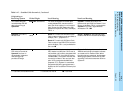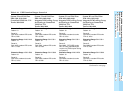
MERLIN LEGEND Communications System Release 6.1
Network Reference
555-661-150
Issue 1
August 1998
Call-Handling Scenarios
Page 2-76Network Configuration Scenarios
2
Non-Local Dial Plans and Facilities Planning 2
This section explains how non-local dial plans, calling groups, switch identifiers,
UDP routing, ARS routing, and remote access are set up for each system. Not all
details are provided for all facilities and extensions.
Intersystem calling is not illustrated in detail for Scenario 4, but Table 2–19, page
2-79 shows the applicable extension ranges, patterns, and primary routes for
tandem and PSTN facility pools when people in one system call people at non-
local dial plan extensions. Some UDP routes are reserved for high-speed
data/video calls between systems, and a pair of extension numbers (5610–5611)
on the headquarters System E is dedicated to executive videoconferences. When
considering intersystem calling, keep the following facts in mind:
■ Intersystem voice calls to and from System G do not display calling name
or number information at MLX display telephone or PassageWay
recipients, because these calls travel over tandem tie trunks.
■ Notice that because System G is connected to the private network by
analog tandem tie trunks, its BRI facilities are used by users at other
systems to call the single 2B data extension on System G. The 2B data
extension on System G is a video system, and users there call only certain
video extensions on other private network systems (only the executive
video extension on System E is accessed, for example). If a System H user
calls a 2B data extension on System G, the call is routed first over tandem
PRI facilities to System E, which prepends the necessary digits and sends
the call over the PSTN on a PRI facility. When the call arrives on the
System G BRI facility, it is routed directly to the video system.
■ Because tandem tie lines are used instead of PRI tandem trunks to
connect system G to system E, inside calls to the centralized VMS/AA
appear as outside calls. For the centralized VMS/AA, this means that all
calls are treated as outside calls and the centralized VMS/AA cannot
provide different call handling and/or greetings based on the type of call.
Also, Message Waiting Light updates for non-local extensions compete
with other voice and data calls for tie lines and touch tone receivers, and
are queued with other calls, so there may be delays in Message Waiting
light updates.
NOTE:
It is recommended that PRI lines, rather than tie lines, be used
between MERLIN LEGEND Communications systems in a private
network that utilizes the Centralized Voice Mail feature. Refer to
Table 1–1, page 1-11
for advantages of PRI lines.
■ Similarly, the System G users access its PSTN BRI facilities when they
must reach 2B data extensions on other private network systems.


















